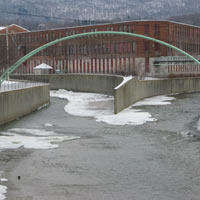How clean is the Hoosic River?
 |
| The flood-control chutes have a commanding presence at the confluence of the north and south branches of the Hoosic, just below the Massahcusetts Museum of Contemporary Art in North Adams. (Photo by Glenn Drohan) |
 |
| The flood-control chutes have a commanding presence at the confluence of the north and south branches of the Hoosic, just below the Massahcusetts Museum of Contemporary Art in North Adams. (Photo by Glenn Drohan) |
| If you would like to contribute information on this article, contact us at info@iberkshires.com. |